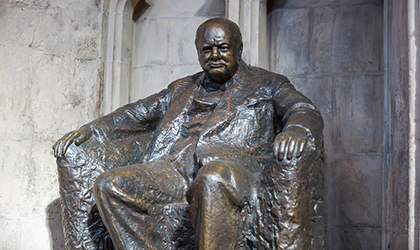
Rick Wicklin, over at The DO Loop blog, published an interesting graph showing the ages of US Presidents at the beginning and end of their terms, from George Washington to the current occupant of the White House.1 Inspired by his analysis, we extracted data2 from Wikipedia on ages of the Prime Ministers (PMs) of the UK – from Robert Walpole in 1721, regarded as the first PM, to the incumbent, Theresa May.
One of the main differences between the US and the British political system is that the former uses fixed terms of four years, with no President serving more than two terms,3 while in Britain a PM could, in principle, continue indefinitely – assuming they are re-elected at each general election and avoid being removed as leader, either by their party or the monarch, in the period of up to five years between elections.
Table 1 shows summary statistics of the ages of UK PMs at the beginning of their first term and at the end of their final term, as well as the time that elapses between their first appointment as PM and their ultimate departure from office, including any out-of-office breaks.4
TABLE 1 Summary statistics for age-related variables of UK PMs.
| Min | 1st quartile | Median | Mean | 3rd quartile | Max | |
| Age at start | 24.6 | 46.4 | 54.0 | 53.2 | 60.2 | 70.3 |
| Age at end | 34.3 | 53.1 | 60.6 | 61.0 | 69.5 | 84.2 |
| PM time (including breaks) | 0.3 | 2.1 | 6.2 | 7.8 | 11.6 | 26.5 |
| Age at death | 44.4 | 65.5 | 74.5 | 72.9 | 81.6 | 93.0 |
| Years lived after leaving office | 0.0 | 1.2 | 8.6 | 11.9 | 21.7 | 41.1 |
This table led us to identify six time-related records related to PMs. First, three old records which look impossible to beat:
- William Pitt the Younger5 becoming the youngest-ever PM, aged 24.6 years, in 1783. Pitt the Younger completed a PM span of almost 19 years, though that includes an out-of-office period between 1801 and 1804; he became PM again at the end of that period and remained so until his death in 1806.
- William Cavendish-Bentinck, 3rd Duke of Portland, whose PM time spanned 26-and-a-half years over two terms: the first lasting around a year, and the second only a year and a half. The two terms were separated by a 24-year gap, the longest such period in history.6
- William Gladstone ending his fourth term as PM aged 84.2 years; he became PM for the first time aged almost 59.
Second, three records which may be broken in due course:
- James Callaghan, later Baron Callaghan of Cardiff, dying one day before his 93rd birthday, making him the longest-lived PM.
- Augustus FitzRoy, 3rd Duke of Grafton, who lived for more than 41 years after leaving office for the last (and only) time; he was appointed aged 33 and was PM for just over a year.
- Henry Temple, Viscount Palmerston, who started his first term aged 70.
The distributions of ages at the start and end of Premiership and at death all seem to be approximately normal (except for Pitt the Younger’s very early age), and despite outliers like FitzRoy, the distribution of years lived after leaving office is bimodal, with increased values for PMs who lived in any part of the 20th and 21st centuries.
We analysed the time-related patterns of age at first term and age at death for PMs, as shown in the Lexis diagram in Figure 1. Note that we refer to PMs using their name and surname rather than their title, and that we have coloured the lines by party, and marked survival. Since we are only interested in describing natural trends in the data rather than in a modelling exercise, we fitted loess-based smoothers to these two outcomes; they are shown as black lines, continuous for age at death and dashed for age at start of first Premiership. We used functions from the R package ggplot2 to produce Figure 1. Note that the smoother for age at death excludes PMs who are alive at the time of writing.
FIGURE 1 Time-related ages at the beginning of first term as PM and at death. Colours indicate political party. The solid portion of each coloured line is the period of Premiership (including breaks). A star (*) is used to indicate when an individual stops being PM, after which a dashed line shows the remainder of their life, terminating in a triangle for those who are now deceased, and a circle for those who were still alive at the time of analysis (16 December 2017). Loess-based smoothers are shown as black lines, continuous for age at death and dashed for age at start of first Premiership. (Click image for full-size version.)
The ages at the start of Premiership can be described in four epochs:
- PMs becoming younger from 1720 to 1775.
- PMs getting older, from approximately 45 years of age in 1775 to around 57 years in the 1850s.
- A plateau at 57 years of age from the 1850s, coinciding with the death of the dominant figures of the first part of the Victorian era, lasting up to governments formed in the early years of the present monarch’s reign (1952-).
- A steady movement towards younger PMs, aged between 45 and 55, from 1925 onwards – though there are three notable exceptions, Chamberlain, Churchill and Attlee, who were aged over 62 when first elected around the time of the Second World War.7
The ages at death follow a constant pattern between 1875 and 1925, after which a steady increase in survivorship starts. Note the seemingly identical rate of increase in age at death for the periods 1775–1875 and 1925 onwards, which is also similar to the rate of increase in age at first term as PM between 1775 and 1850.
We have presented a brief example of how analysing historical datasets can provide interesting insights into long-term political processes. The database, and the code to generate Table 1 and the Lexis diagram in Figure 1, can be seen here.
Apart from the above-mentioned blog by Rick Wicklin, a more complex study also including Lexis diagrams and a Bayesian survival analysis of Roman Catholic Popes is presented in the paper by Stander, Dalla Valle and Cortina-Borja (2017).8
About the authors
Mario Cortina Borja is chairman of the Significance editorial board, and professor of biostatistics in the Population Policy and Practice Programme, Great Ormond Street Institute of Child Health, University College London. Julian Stander is associate professor (reader) in mathematics and statistics in the School of Computing, Electronics and Mathematics, Plymouth University.
Footnotes and references
- Whose name, paraphrasing the opening sentence of Don Quixote, we do not care to remember. ^
- And corrected a few dates wrongly shown in that database. ^
- The only exception is Franklin D Roosevelt, who served three full terms and died two months and 23 days into his fourth term. He was President between 4 March 1933 and 12 April 1945. The US Constitution has, since 1951, limited Presidents to just two terms. ^
- For instance, Churchill was PM between 10 May 1940 and 26 July 1945, and then again between 26 October 1951 and 6 April 1955; thus we take his PM time to be almost 15 years. ^
- Named “the Younger” to distinguish him from his father, William Pitt the Elder, also a PM. ^
- Though this doesn’t appear in the table, Robert Walpole completed almost 21 continuous years in office between 1721 and 1742, surely a record impossible to beat. ^
- The last PM beginning their Premiership aged over 60 was James Callaghan (64.03) in 1976; the last one becoming PM for the first time aged over 65 was Churchill (65.44) in 1940. ^
- Stander, J., Dalla Valle, L. and Cortina-Borja, M. (2017) A Bayesian survival analysis of a historical dataset: How long do Popes live? The American Statistician, to appear. (A shorter version of this paper was published in Significance.) ^





